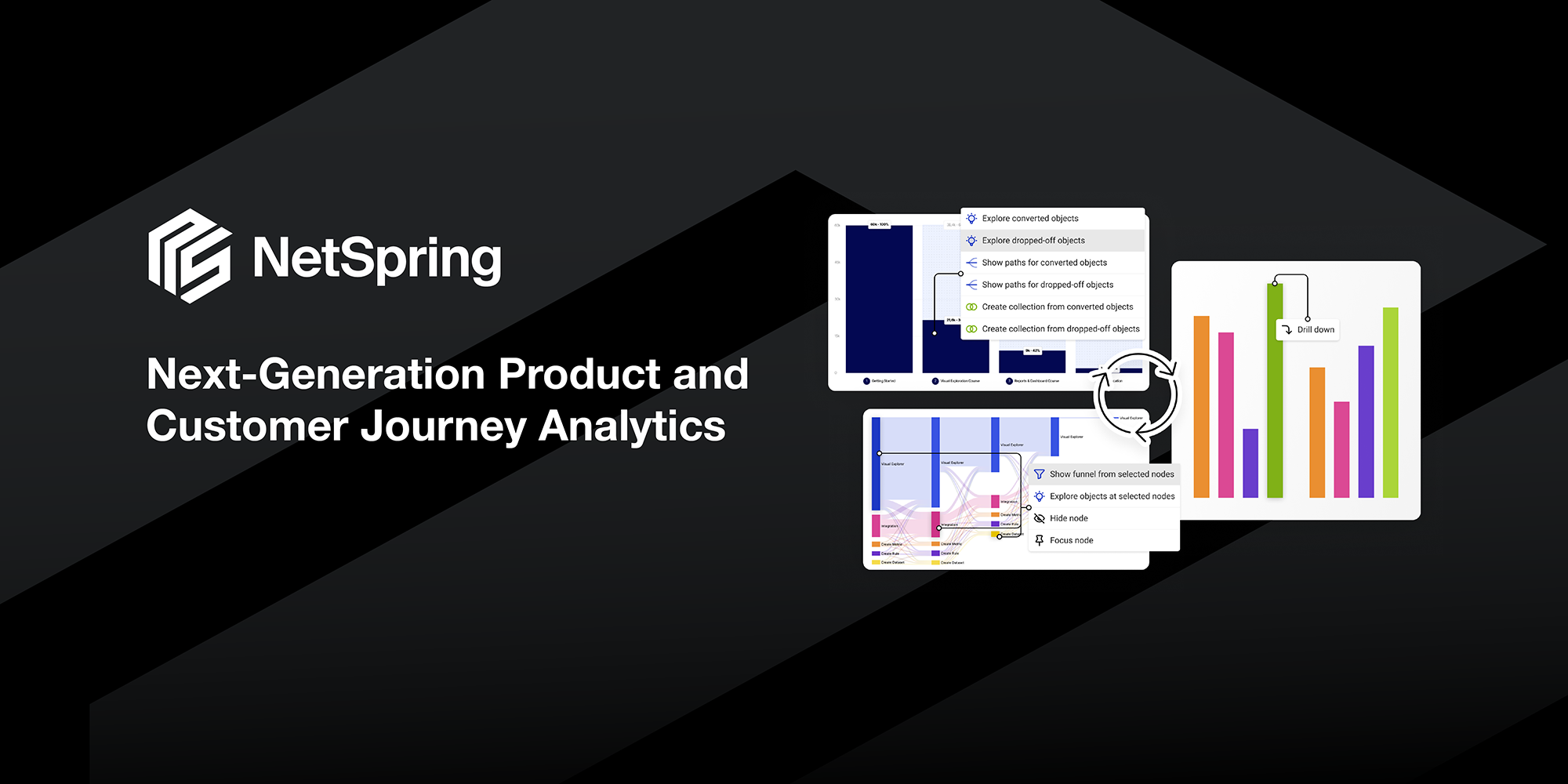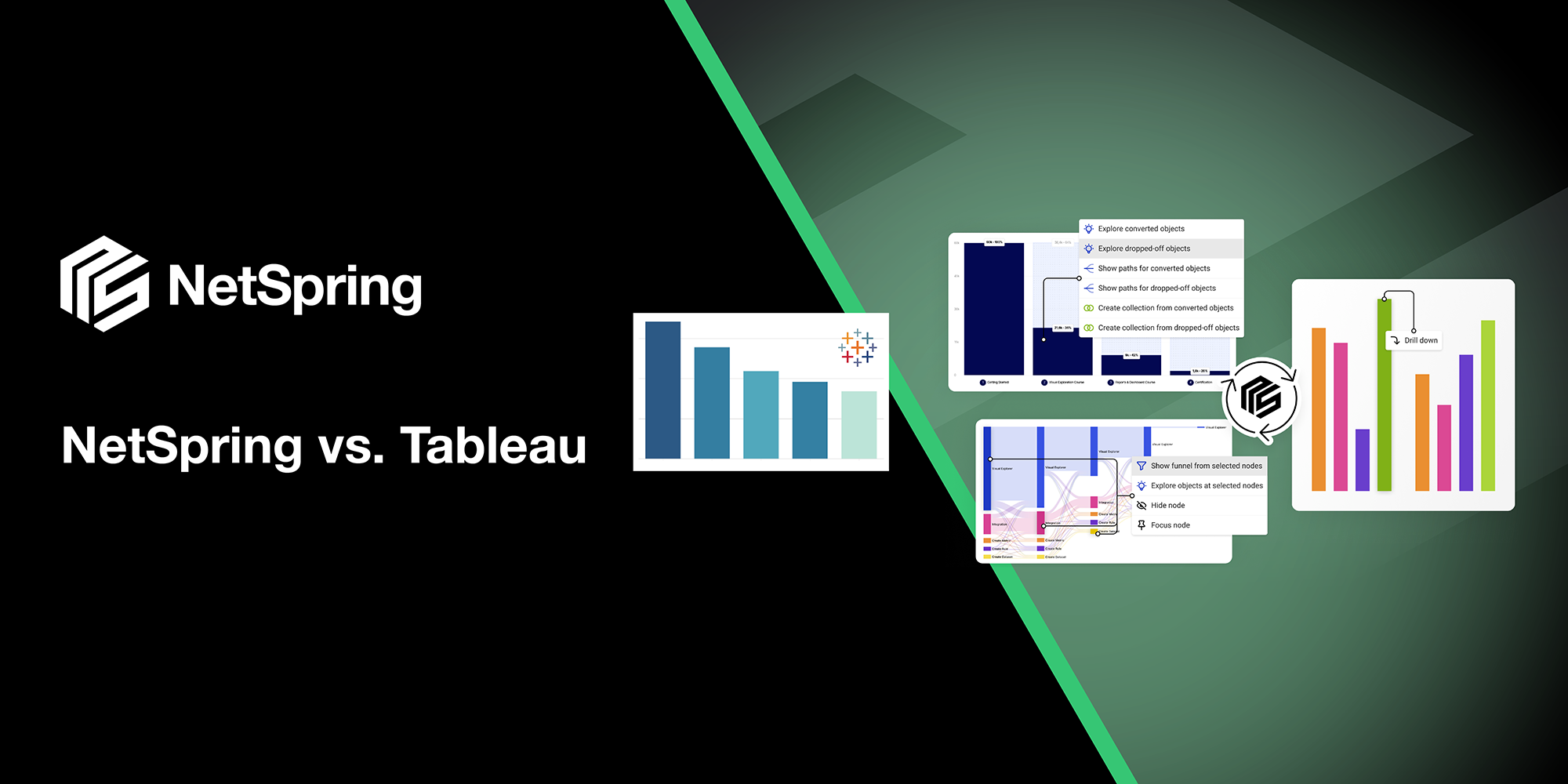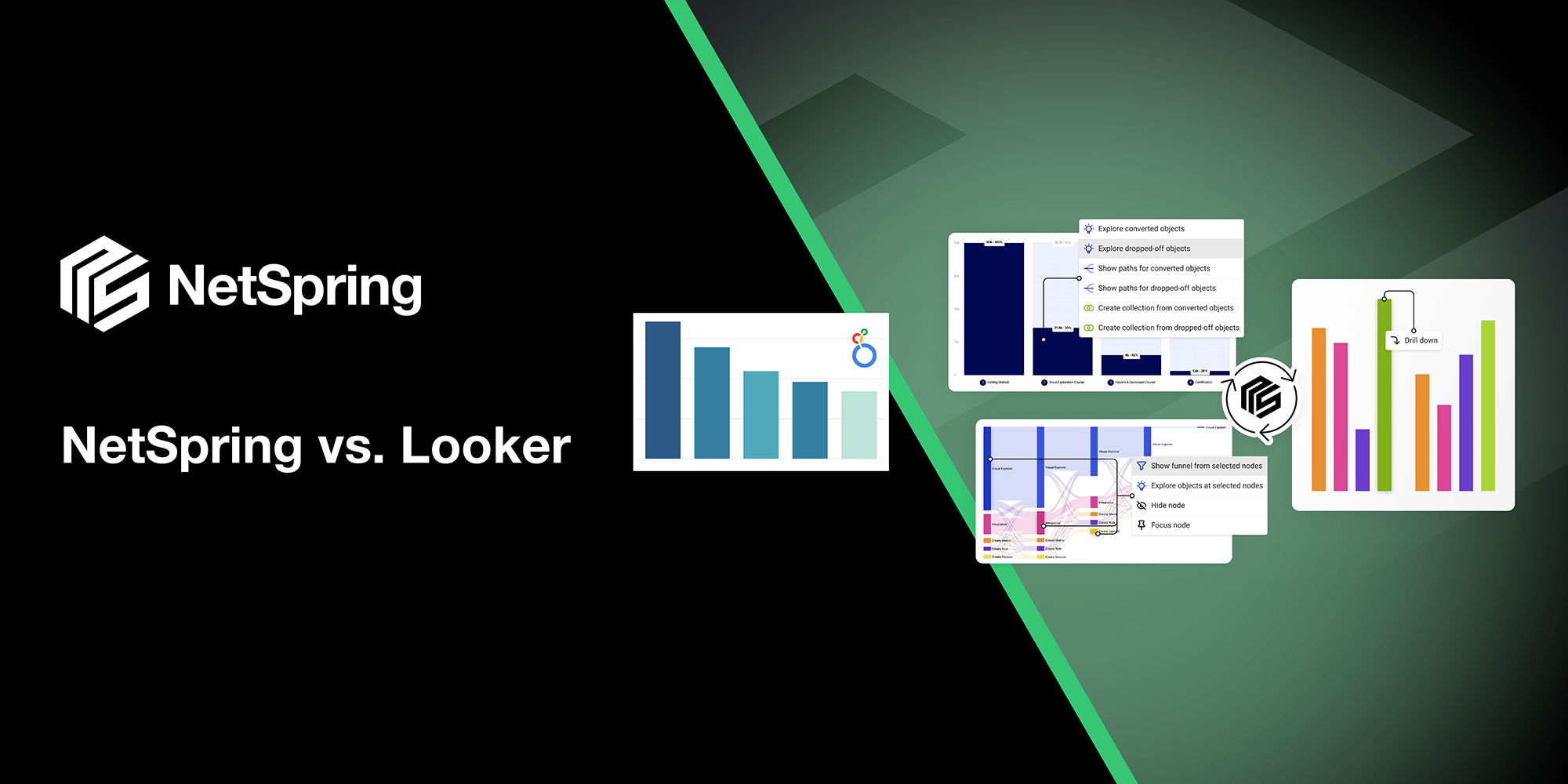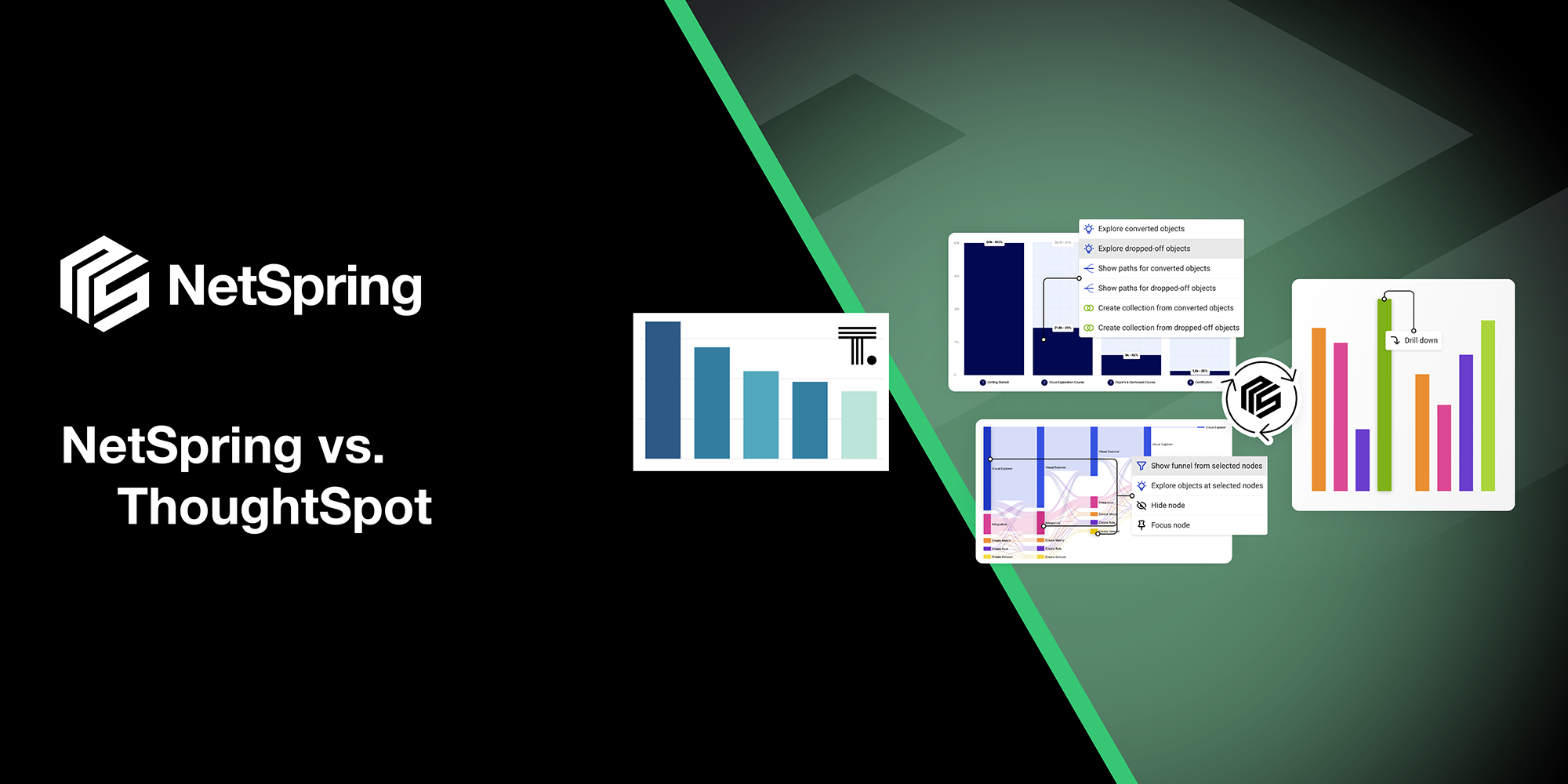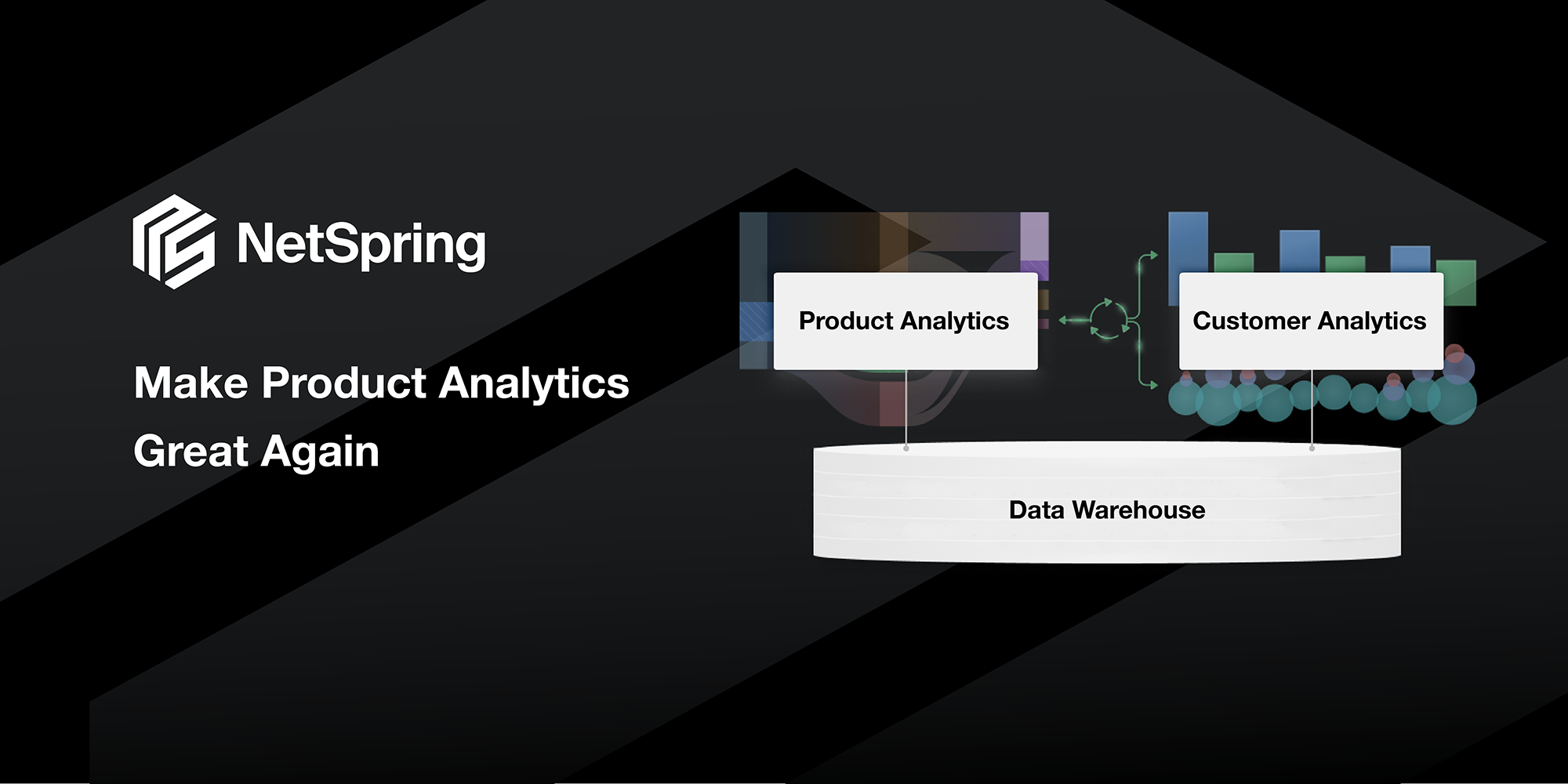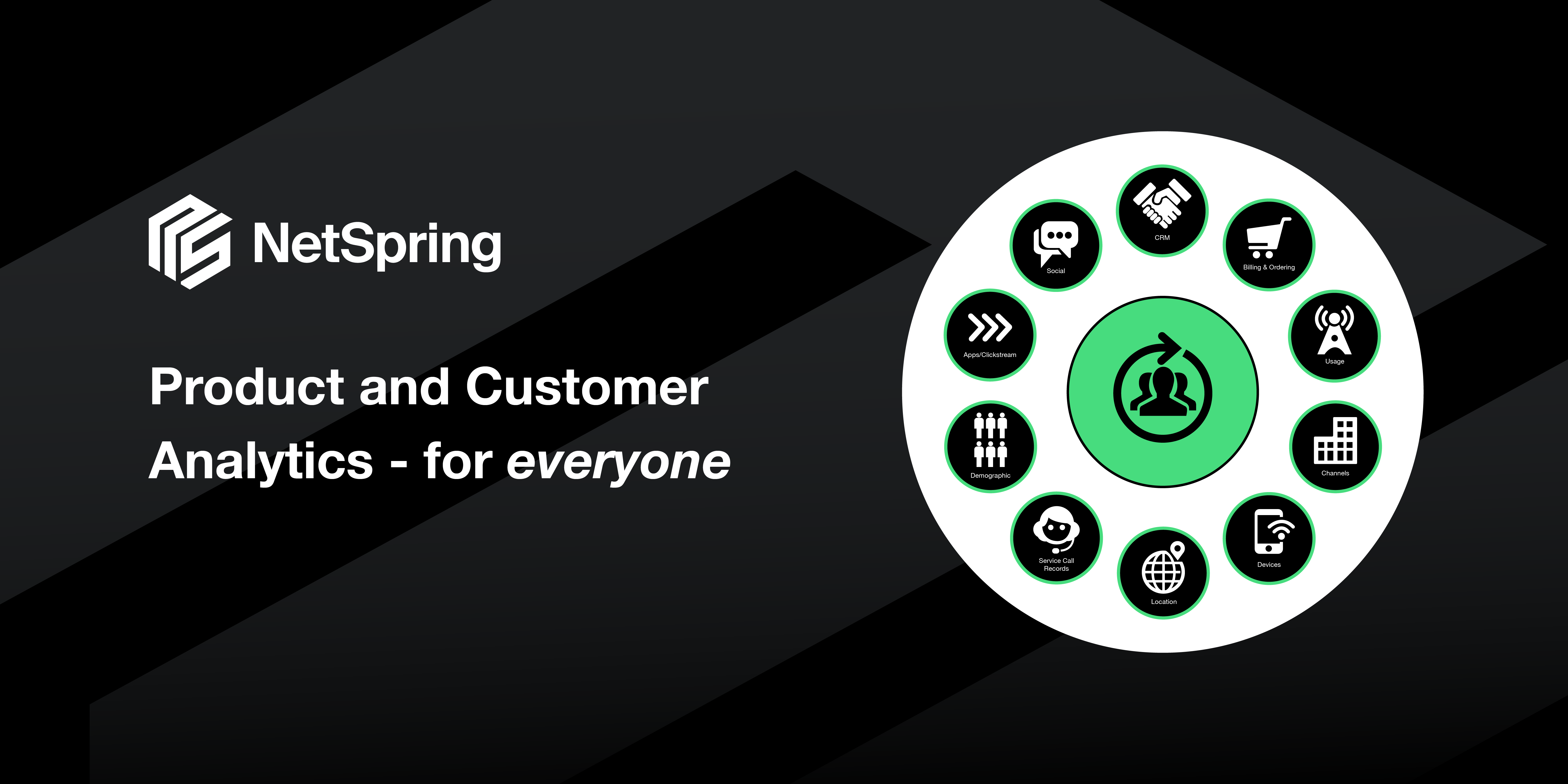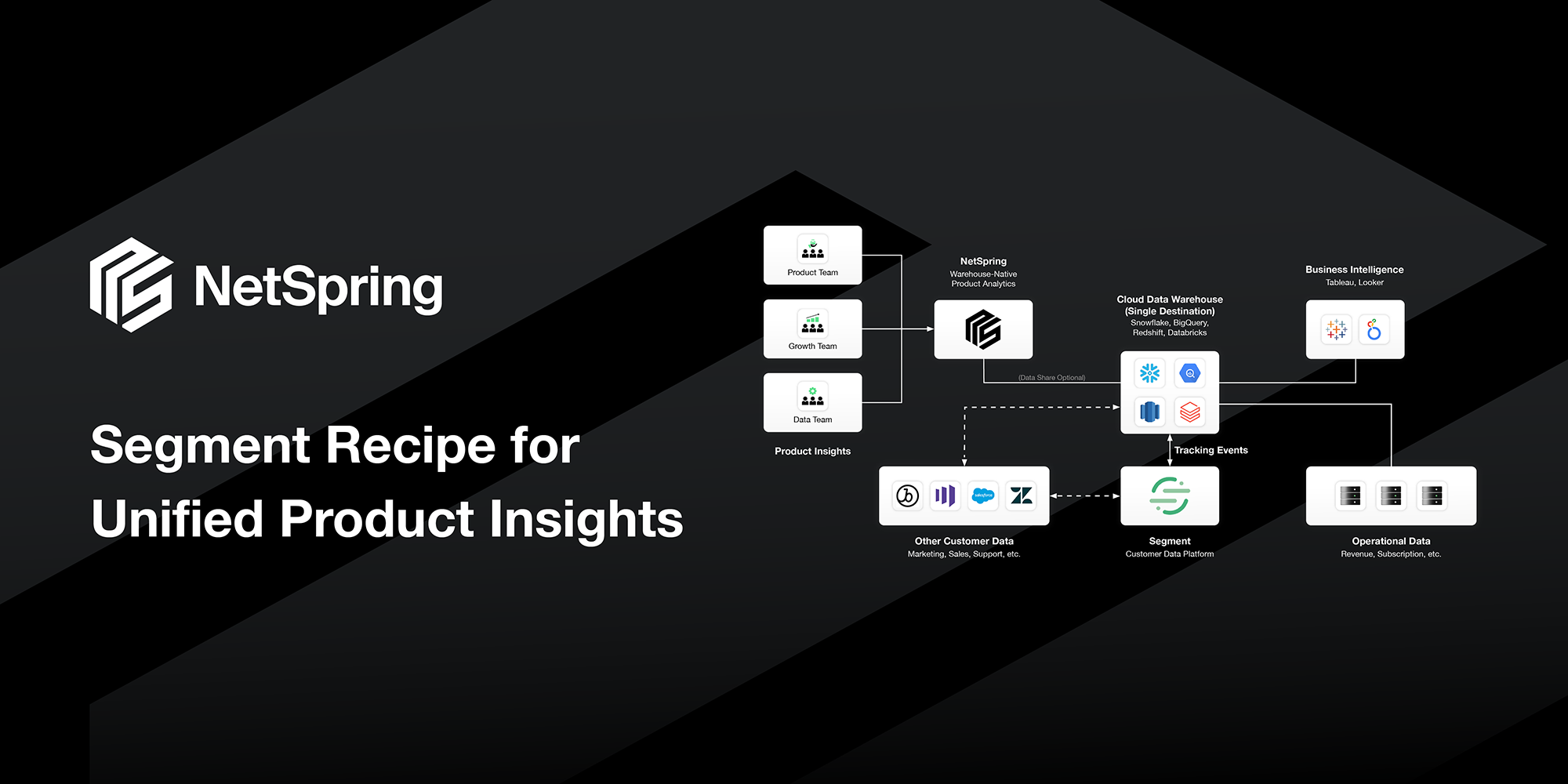At NetSpring we are at the forefront of a revolution in the product analytics space. NetSpring’s warehouse-native product analytics platform unlocks huge business value that traditional first-generation tools like Amplitude/Mixpanel have not been able to.
Modern warehouse-native architectures have cost, security, privacy, and governance advantages. A single analytics tool like NetSpring working directly on top of the single source of truth in the warehouse, has advantages of consistent, trustworthy analytics which can be confidently relied upon for making data-driven business decisions. But there is a lot more than just getting classic product analytics working on top of the data warehouse.
Traditional product analytics is siloed, working only on product instrumentation streams. At best, you can augment the analytics minimally with some properties from the warehouse artificially tacked on to User or Event objects through painful reverse ETL. But analysts often want a lot more. They want to be able to analyze across a variety of entities in the data warehouse e.g. Account, Campaign, Advertisement, Subscription, Workspace, Project, Document, Contract, Survey, Store, Chat, Call etc. They also want to consume these in a natural fashion, modeling them and the relationships between them as they exist in the warehouse. NetSpring provides the ability to do exactly that, which results in opening up a huge class of analytics that is much more business impactful than just studying feature usage in a traditional first-generation product analytics tool. This is analytics across the entire customer journey. We call this “customer journey analytics” or “customer analytics”.
Customer journey analytics encompasses product analytics and is much broader and more business impactful than traditional siloed product analytics.
The early evolution of Product Analytics
First, let’s try to understand how traditional product analytics tools like Amplitude/Mixpanel evolved. They emerged a decade ago when a large number of mobile apps and product-led SaaS services became pervasive. It was critical to get an understanding of product usage by users, particularly in consumer-oriented products where churn was high. At that time, there were no good options to do this well. The available analytics tools were primarily BI tools like Tableau and Qlik. These tools were good for reporting on ERP, CRM, HCM, etc. data in the warehouse. But they could not be used for product analytics because:
-
- Event data from product instrumentation never reached traditional (on-prem or even early cloud) data warehouses. Data warehouses were not designed to ingest, store, and process event data in a performant and cost-effective way.
- BI tools were not designed for expressing or computing event-oriented analyses.
- Fast moving digital product and marketing teams needed a quick solution that did not depend on slow-moving central enterprise data teams.
As a result of the above limitations, purpose-built, packaged tools for product analytics emerged; tools that included everything in a single SaaS service – instrumentation, storage, compute, and visualizations. For once, product and growth teams were able to get visibility into their product’s usage. They were able to perform basic analysis such as event segmentation, funnel, paths, etc. using ready-made templates. They were able to use these analyses to optimize product features. This was a huge breakthrough.
Need for the next-generation of Product Analytics
Product and Growth teams started adopting these first-generation tools. Huge amounts of money were spent on these tools that got very expensive as companies grew, and their event volumes increased rapidly. There was a belief that business-impactful decisions would be made based on analytics in these tools, and the spend on these tools would pay off. However that was not the case.
Consider a traditional product analytics tool showing you that conversion rates have increased following the release of a new feature. However, what if the majority of customers who converted ended up canceling by calling your call center? That data is not in the siloed product instrumentation stream that traditional tools work with. It is in a different business system that is inaccessible to first-generation product analytics tools. Similarly, can you understand the impact of a product change on support tickets/calls – data that is in Zendesk? Can you understand product engagement by subscription tier – data that is in Salesforce? Can you be alerted to product friction or increased engagement in accounts whose renewal is coming up in a month – data that is in NetSuite?
Can you break down subscription revenue by cohorts of customers? Can you prioritize product issues based on impact on revenue? Can you target the right set of customers with the right campaigns/offers/nurture based on their lifetime value?
It is no longer sufficient to understand narrowly-defined product metrics based on just product instrumentation data. As modern businesses evolve to product-led growth, product teams are quickly becoming revenue centers, and need to graduate from product metrics to business metrics, with product instrumentation data being just one source of input. They need a business analytics tool that provides a broader view. They need business analytics to be more impactful and influential with the C-suite.
First-generation tools have made feeble attempts to address this with simplistic “reverse ETL” solutions. But these solutions are cumbersome, incomplete, and expensive. So as customers grow, they invariably end up doing more and more of the heavy lifting in BI tools.
In summary, the need for the next generation of product analytics arises from the following limitations of first-generation tools:
-
- The analytics in these first-generation tools is so siloed on such limited (and often poor quality) data, that no significant business-impactful decision can be made on it.
- The cost is so high, that when compared to the benefits, the ROI is just not there.
- Beyond the first, basic analytics in these tools, business teams ended up calling Data teams to build them reports for the second level of insights, often struggling to explain requirements, waiting for weeks to get reports, and not being able to get analytics fast enough for it to be actionable.
- Data teams struggle with extracting data from proprietary product analytics tool “black holes” into the data warehouse, and using a BI tool (the wrong tool for product analytics, but the only tool available!) to produce reports.
- Analytics becomes fragmented across product analytics and BI tools, with very low trust in the numbers produced by the first-generation product analytics tools.
- Security teams, with increasingly demanding compliance and governance requirements, limit the data that can be sent to external analytics services, contributing to the diminished analytical value of these tools.
Traditional product analytics has not lived up to its promise. It is no wonder that the majority of product analytics today is not done in traditional product analytics tools! They are done (painfully!) in BI tools. But the need for product analytics has only increased, as more and more software is consumed as subscription SaaS services, and product-led growth becomes the primary business methodology for more and more product-led companies. Having a deep understanding of product usage and customer behavior is critical for survival in a competitive market.
In order to effectively serve the increasing needs for product analytics and to make it more effective, we need a new generation of tools like NetSpring.
Evolving from Product Analytics to Customer Journey Analytics
The first step in the upgrade of product analytics is to not think of product analytics anymore, but rather to think of a broader “Customer Journey Analytics” or “Customer Analytics”. Customer Journey Analytics is analytics across product instrumentation data and all other customer business data (sales, support, finance, marketing, success, etc.).
Analytics is no longer just about usage of product features; rather it is about how the usage impacts business – such as revenue generated or support escalations caused. It is about retention numbers that are not misleading because it now correctly includes cancellations outside of the product. It is about optimizing the right set of features for the right set of accounts that generate the most revenue. It is about measuring marketing impact not just by number of signups following a campaign, but on longer-term economic value of acquired customers. It is about understanding customer journeys not just in product, but also across all channels such as store, support, chat, loyalty programs, partners etc. It is about success and support teams driving more CSAT and retention by understanding behaviors of users in their accounts. It is about operational teams being able to evaluate the business impact of product/site experiences, and using that to prioritize issues better.
Customer Journey Analytics provides a shared, consistent, and easily accessible view of customer behavior for all customer-oriented teams in the enterprise, cutting across all customer touch points – in-product or outside product.
Breaking data silos
The first step to realizing the Customer Journey Analytics vision is to break data silos and converge on a single data store. In enterprises today, the undisputed single store for all data is the data warehouse/lake. Modern cloud data warehouses such as Snowflake, BigQuery, Redshift, and Databricks have ushered in the consolidation of all data into a single store. While the warehouse has always been the central place for data used in business reporting, the big change now is that modern warehouses are also becoming the central place for event-oriented data e.g. clickstream, IoT, logs, devices data, in addition to the traditional state data (business transactions from POS, order capture, supply chain, sales, finance, HR etc.). It is now feasible to ingest and store large-scale event data too in the warehouse quickly and efficiently.
The data warehouse/lake is the center of gravity of all data in the enterprise – event data and state data.
All applications, including Product and Customer Journey Analytics, should adapt to this change and re-tool to avoid copying data out to their proprietary silos. NetSpring is built from ground-up as a warehouse-native platform and never makes a copy of your data, ever.
Next-generation CDPs
The CDP space, which is directly related to product and customer journey analytics, is being re-defined too. CDPs emerged as a marketing solution that was disconnected from the central enterprise data systems and teams. While they provided quick value in the early years, they have suffered from the same pain of siloed systems. Today, next-generation composable CDPs are being re-built on top of the data warehouse with best-in class tools – RudderStack and Snowplow for instrumentation, Hightouch and Census for activation, DBT for data transformations related to identity resolution, sessionization, etc., NetSpring for analytics, and warehouse-integrated AI/ML capabilities for attribution and prediction.
At the core of Customer Journey Analytics is of course the Customer entity. Higher the quality and richness of the Customer entity, better the analytics.
Next-generation CDPs, with their rich customer data models, are an enabler for richer customer journey analytics.
Breaking analytics silos
Once you have a single source of all data in the warehouse/lake, the next step is to have a single analytics tool for all customer-oriented analytics that can leverage this data. Analytics tools have a layer of metadata (such as definition of metrics) above the tables in the warehouse/lake. Having a version of this metadata in many different tools results in multiple sources of truth which is undesirable. Context sharing across multiple tools, even if they are working off the same underlying store, becomes difficult because they each have their own representation of context e.g. a cohort of users that dropped off between two stages of a funnel. A single Customer Journey Analytics tool avoids these issues of fragmented and weak analytics.
A single Customer Journey Analytics tool serves the needs of Product, Growth, Marketing, Sales, Success, and Support teams for all their analytics needs.
This has not been possible historically because event-oriented systems (such as Product Analytics) and state-oriented systems (such as BI) are architected differently in their metadata representations and computation mechanisms. However, this is just the way these systems have evolved historically. While technically challenging to build, it is possible to have a single analytics tool that can bring together the event and state oriented worlds together – NetSpring has proven that.
Building trust
With a single analytics tool working off a single source of truth with no copies, trust in numbers is built up within the organization. A retention number, for example, that is calculated in this single tool is the same number quoted by all teams, and can be presented to the C-Suite with confidence. The tool should have audit capabilities to be able to see the exact SQL that was issued to the underlying warehouse for independent verification of any analytical computation.
With trust in numbers comes more usage of analytics across all teams in the enterprise, and more business value.
Generating ROI
With a broader Product and Customer Journey Analytics platform, the ROI is much higher. Costs are lower with no data copies and no management of data movement jobs. Processes are efficient with no wasted time debugging discrepancies across silos. Security and governance costs are reduced with a single copy of the data under the enterprise’s control, and with carefully controlled access to the central store. With analytics becoming more business impactful by incorporating richer business context and serving multiple teams, the spend on analytics can easily be justified.
Customer Journey Analytics tools can potentially provide an order of magnitude better ROI that traditional Product Analytics tools.
Consolidation
If you think of customer journey analytics as a combination of product analytics, marketing analytics, and digital experience analytics, and map it to the current set of vendors, you see a lot of fragmentation and overlap. But a much needed consolidation trend has already begun. In addition to this, we need to see the consolidation of the majority of event-oriented analytics done today in generic BI tools, into a first-class Customer Journey Analytics tool. This is what NetSpring is building towards.
NetSpring aims to provide a cohesive, yet composable, Customer Journey Analytics suite on a modern data warehouse/lakehouse architecture.

Upgrade to the next generation of analytics with NetSpring
NetSpring is ushering in the next generation of product and customer journey analytics – purpose-built from ground-up for the modern data stack. This is part of a larger vision to be the “Analytics Cloud” – the go-to platform in enterprises for all business-oriented analytics.

With NetSpring, you can make data-driven decisions with confidence in a single, consistent, trustworthy, cost-effective, self-service tool. Make a real impact on business outcomes with NetSpring.
Sign up today for a 14-day risk-free trial.


